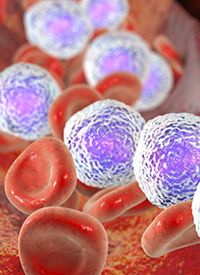Interrupting Venetoclax Triplet After MRD Negativity Is Feasible in Relapsed/Refractory Mantle Cell Lymphoma
January 12, 2021 - Stopping combination treatment with venetoclax, lenalidomide, and rituximab after achieving minimal residual disease negativity in patients with relapsed/refractory mantle cell lymphoma is feasible.

Stopping combination treatment with venetoclax (Venclexta), lenalidomide (Revlimid), and rituximab (Rituxan) after achieving minimal residual disease (MRD) negativity in patients with relapsed/refractory mantle cell lymphoma is feasible, according to phase 1/2 findings from the VALERIA trial that were presented during the virtual 2020 ASH Annual Meeting and Exposition.
The preliminary results showed that the MRD-driven triplet yielded a molecular remission rate of 39% at 6 months, said lead study author Mats Jerkeman, MD, PhD, in a presentation during the meeting.
Assessment for MRD at 6 months among the first 22 patients enrolled revealed that 2 patients had no MCL cells in either the blood or bone marrow and 7 patients were MRD-negative.
At 6 months, the overall response rate (ORR), which was the primary endpoint, was 59%, with 10 (45%) complete responses (CRs) and 3 (14%) partial responses (PRs). Two (9%) patients had stable disease as their best response.
“We would have hoped for perhaps a higher response rate in this trial than we’ve seen so far but it’s still early, with only 22 patients, so it’s a small sample,” said Jerkeman, project manager of Lymphoma - Clinical Research, Lund University and Skane University Hospital in Lund, Sweden. “Two of the four patients who had received ibrutinib [Imbruvica] before responded to this combination, so the response seems similar in ibrutinib-naïve and ibrutinib-exposed patients.”
Eligible patients for VALERIA had histologically confirmed stage I to IV MCL and had received at least 1 prior rituximab-containing chemotherapy regimen, with documented relapse or disease progression following the last anti-MCL treatment, or were not considered to be candidates for chemotherapy due to frailty or comorbidity.
The treatment schedule consisted of weekly rituximab for 4 weeks and then every 8 weeks, lenalidomide on days 1 to 21 of the 28-day cycle, and daily venetoclax, including during ramp-up. The rituximab induction schedule was 375 mg/m2 intravenously (IV) on day 1 in cycle 1; then 1400 mg subcutaneously (or 375 mg/m2 IV) on days 8, 15, and 22 in cycle 1; then day 1 in cycles 3, 5, 7, 9, and 11.
The phase 1 portion was a 3+3 design in which 3 patients were treated with venetoclax at 400 mg, lenalidomide at 15 mg (cohort A), 3 were treated with 400 mg and 20 mg, respectively (cohort B), and 3 received 800 mg and 20 mg of the agents, respectively (cohort C).
Patients initially received 3 months of venetoclax, lenalidomide, and rituximab. Patients who were MRD-negative after 3 months received another 3 months of treatment, at which time treatment was stopped if they were in clinical CR and still MRD negative in the blood and bone marrow by imaging. Patients who were MRD-positive after 3 months continued treatment, with MRD testing every 3 months, until they became MRD-negative. Treatment was restarted when a new evaluation of MRD (performed every 3 months) was positive.
In the 22 patients in the analysis, 12 of whom were from the phase 1 portion, the median age of patients was 71 years and 95% were men. The median number of prior lines of therapy was 2 lines (range, 1-7), including previous ibrutinib in 18% and previous lenalidomide in 5% of patients. Almost two-thirds (64%) received prior autologous stem cell transplant.
At the time of the analysis, 36 of the planned 38 patients were enrolled, 12 from the phase 1 portion and 24 from the phase 2 portion.
Of the 9 patients who eventually had disease progression, 7 did so early, 1 did so after an initial PR, and 1 stopped treatment due to toxicity followed by disease progression. Two patients withdrew from the study to undergo allogeneic stem cell transplant. Four patients are still on treatment at the time of analysis and the 7 in molecular remission have stopped treatment and were still off treatment at a median of 5 months, with 1 patient 14 months out, Jerkeman said.
At a median follow-up of 14 months in all 36 patients, the median progression-free survival has not been reached and 8 deaths have occurred, all due to lymphoma.
In the phase 1 portion, there were no dose-limiting toxicities (DLTs) encountered in cohorts A and B. In cohort C, 2 patients experienced dose-limiting toxicities (both grade 3/4 infections). An intermediate cohort of 3 more patients was then introduced, using 600 mg of venetoclax and 15 mg of lenalidomide, with no dose-limiting toxicities, and therefore this dosage was established as the recommended phase 2 dose.
Regarding safety, the most common adverse events (AEs) were hematologic. Neutropenia occurred in 56% (grade 3/4, 50%), thrombocytopenia in 19% (grade 3/4, 16%), and anemia in 11% (grade 3, 9%). Granulocyte-colony stimulating factor support was required for all patients. The most common nonhematologic toxicity was gastrointestinal-related, and sepsis was the most common grade 3/4 AE, occurring in 4 patients.
Reference
Jerkeman M, Kolstad A, Niemann CU, et al. Venetoclax, lenalidomide and rituximab for patients with relapsed or refractory mantle cell lymphoma - data from the Nordic Lymphoma Group NLG-MCL7 (VALERIA) phase I trial: stopping treatment in molecular remission is feasible. Presented at: 2020 ASH Annual Meeting and Exposition; December 4-8, 2020; virtual. Abstract 122.



